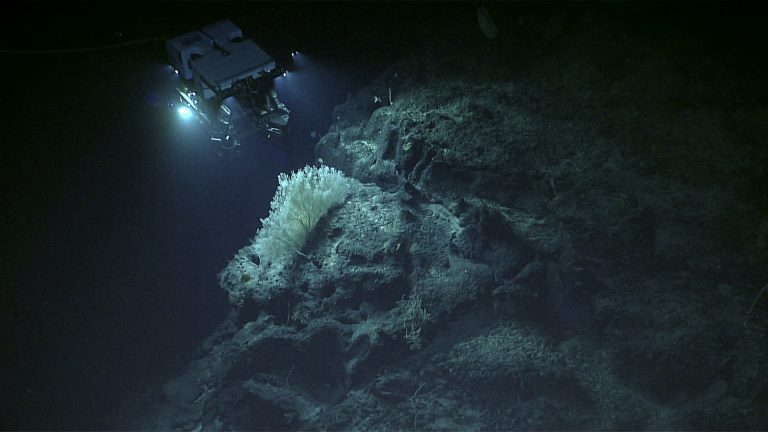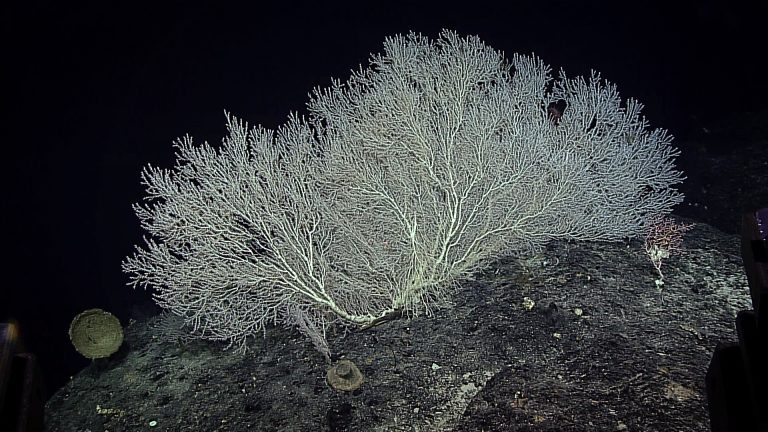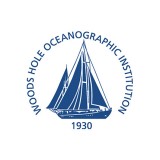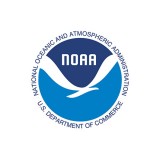The Phoenix Islands Protected Area (PIPA) is the largest and deepest UNESCO World Heritage Site on Earth. Approximately the size of California, PIPA was the first Marine Protected Area (MPA) of its kind. Created in 2008, it is about halfway between Hawaii and Fiji within the territorial waters of the Republic of Kiribati. Above the water, eight low-lying islands exist in the MPA, but the real beauty is below the surface. Huge tracts of deep ocean are pierced by over 25 underwater volcanoes. Seamounts along with atolls and submerged reefs create one of the last isolated coral archipelago ecosystems, virtually untouched by mankind. The biological density is phenomenal with more than 500 fish species, an abundance of sharks and turtles, and at least 120 types of coral – but that is just in the shallows. PIPA is also the first protected area in Pacific where depths exceed 16,400 feet (5,000 meters), and entirely unknown species are sure to live at those depths.
In October, Dr. Erik Cordes (Temple University) and his team will explore never seen before seamounts and atolls within PIPA. Along with Remotely Operated Vehicle (ROV) SuBastian, the science team will conduct some of the first ROV dives in these locations, some down to 4,000 meters. The dive missions will provide a first glimpse of many of these habitats that will help determine what PIPA is protecting at these depths, and inform the future management of this area. In previous seamount expeditions high proportions of new species have been found, and therefore the team is expecting to observe new types of deep-sea corals and their associated species. Scientists also plan to explore how countercurrents running through the study area could create boundaries, providing a better understanding of coral connectivity across the Pacific.
Studying the Deep
 The goal of this study is to greatly increase knowledge of deep-sea coral life and functions in one of the largest marine protected areas on the planet. At this time, the studies and measurements completed in PIPA have primarily focused on shallow coral habitats. Research on reef systems to the depth of approximately 450 feet show that there is a plentiful and flourishing network of coral, algae and other life forms. But in depths beyond, there is no information about deep corals or other communities living in these benthic zones.
The goal of this study is to greatly increase knowledge of deep-sea coral life and functions in one of the largest marine protected areas on the planet. At this time, the studies and measurements completed in PIPA have primarily focused on shallow coral habitats. Research on reef systems to the depth of approximately 450 feet show that there is a plentiful and flourishing network of coral, algae and other life forms. But in depths beyond, there is no information about deep corals or other communities living in these benthic zones.
To get to these depths, the science team will use video from ROV SuBastian to make detailed observations on the community and organisms along with physical samples to provide the proper identifications of the species observed. Some of the observations will be conducted with specialized camera systems to look for bioluminescence and biofluoresence. Water samples and specialized sensors will compliment these studies to provide an understanding of their habitat and associations. This type of research will allow for future comparisons over time as part of an important coral monitoring process.
Findings will make progress towards fundamental scientific questions, such as identifying what species of corals live there, and the diversity of these ecosystems. The data gathered will be used to fill in the puzzle of much larger, global oceanic systems, such as the biogeographic relationship among the Southwest Pacific, Central Pacific, and Hawaiian Islands deep coral communities. The products of this expedition have the potential to advance many fields of research, including understanding the carbonate system and ocean acidification in the deep Central Pacific, symbiotic relationships between corals and associates, and even inter-specific communication.
Acidifying Waters
 The main goal in creating this MPA was granting protection from disruptive human actions. While PIPA is currently protected from fishing activity, the effects of ocean acidification cannot be stopped by lines on a map. Researchers fear that deep-water corals could be affected by this process, especially certain types of hard corals. Rising temperature and declining ocean concentrations in ocean waters could also influence deep-water corals and other important species. These conditions could be very serious in the Pacific, where an amassing of CO2 in older, deep waters coexist with some of the lowest pH values that have been recorded. The conditions in the study locations may provide insight into deep-water corals surviving and growing in low CO2 saturation states.
The main goal in creating this MPA was granting protection from disruptive human actions. While PIPA is currently protected from fishing activity, the effects of ocean acidification cannot be stopped by lines on a map. Researchers fear that deep-water corals could be affected by this process, especially certain types of hard corals. Rising temperature and declining ocean concentrations in ocean waters could also influence deep-water corals and other important species. These conditions could be very serious in the Pacific, where an amassing of CO2 in older, deep waters coexist with some of the lowest pH values that have been recorded. The conditions in the study locations may provide insight into deep-water corals surviving and growing in low CO2 saturation states.
PIPA Process and Outcomes
The size of this protected area, including significant deep-sea regions and seamount habitats, offers a rare chance to establish the effects of “no-take” zones on the deep-sea environment. A baseline habitat evaluation will be critical to understanding the influence of the MPA over time. There is currently no existing baseline for deep-sea communities in the massive central Pacific. Without diagnostic information about the current state of coral and other communities living at deeper depths within the PIPA, there are no records to gauge and describe the results of these protective actions or assess future impacts. This expedition will give insight to an entirely unexplored region of the deep sea and demonstrate the importance and use of baseline data for evaluation of MPAs.
Data & Publications
The resulting shipboard dataset is being archived at Rolling Deck to Repository and is now available.
Processed acoustic backscatter and swath bathymetry from Falkor and Images, Event logs, and Navigation from ROV SuBastian have been archived at MGDS.
Water temperature, salinity, total alkalinity, carbonate chemistry, and other parameters from CTD casts and water samples collected during the cruise are archived in NOAA’s NCEI, NCEI accession #0182941).
ADCP data is curated and archived by University of Hawaii.
Genome sequencing from microbial samples with the boundaries of the Phoenix Island Protected Area are archived in NCBI.
The sequencing data from the Moritella microbe sequences found on this expedition are archived in NCBI.
- Vogt, D., Becker, K., Phillips, B., Graule, M., Rotjan, R., Shank, T., Cordes, E., Wood, R. and Gruber, D. (2018). Shipboard design and fabrication of custom 3D-printed robotic manipulators for the investigation of delicate organisms. PLoS ONE 13 (8): e0200386, doi: 10.1371/journal.pone.0200386. [This article has been published as OPEN ACCESS].
- Auscavitch, S., Deere, M., Keller, A., Rotjan, R., Shank, T., and E. Cordes. (2020). Oceanographic Drivers of Deep-sea Coral Species Distribution and Community Assembly on Seamounts, Islands, Atolls, and Reefs within the Phoenix Islands Protected Area. Fron. Mar. Sci., 7, doi: 10.3389/fmars.2020.00042. [This article has been published OPEN ACCESS].
- Amon, D., Kennedy, B., Cantwell, K., Suhre, K., Glickson, D., Shank, T. and R. Rotjan. (2020). Deep-sea Debris in the Central and Western Pacific Ocean. Front. Mar. Sci. 7:369, doi: 10.3389/fmars.2020.00369.
- Cordes, E. (2019). What are the Limits of Deep-sea Coral Distribution? Invited Keynote Lecture, International Symosium on Deep-sea Corals, Cartagena, Colombia.
- Gauthier, A., Chandler, C., Poli, V., Gardner, F., Tekiau, A., Smith, R., et al. (2021). Deep-sea microbes as tools to refine the rules of innate immune pattern recognition. Science Immunology, 6(57), doi: 10.1126/sciimmunol.abe0531.
Live RoV Footage
ROV SuBastian live dives from the Pacific Ocean
In the News
The Deep Ocean Reveals Surprising Discovery About Human Immunity
SevenSeas Media • April 1, 2021
Scientists make a shocking discovery in the Pacific depths
MENAFN • April 1, 2021
Some Deep Sea Bacteria Are So Strange, Our Immune Sensors Miss Them
Scientific American • March 29, 2021
The Deep Ocean Reveals Surprising Discovery About Human Immunity
ROV Planet • March 22, 2021
Где границы неспецифического иммунитета?
22 Century • March 19, 2021
Bactérias “invisíveis” levam pesquisadores a repensar nosso sistema imunológico
Gizmodo Brazil • March 18, 2021
Microbes raised from the depths in the pacific ocean which cannot be seen by human immunity
World Stock Market • March 18, 2021
“Invisible” Deep-Sea Bacteria Can Slip Past The Human Immune System Undetected
IFLScience • March 18, 2021
Deep Sea Science: Deep Sea Reveals Insights On Human – Marine Technology News
Tech Register • March 17, 2021
Deep Sea Science:Deep Sea Reveals Insights On Human – Marine Technology News
Business Fast • March 17, 2021
Deep Sea Science:Deep Sea Reveals Insights On Human – Marine Technology News
Wired Focus Tech News • March 17, 2021
Deep Sea Science: Deep Sea Reveals Insights on Human Immunity
Marine Technology News • March 17, 2021
Researchers discover deep sea microbes invisible to human immune pattern recognition
Medical Xpress • March 16, 2021
‘Invisible’ Deep-Sea Bacteria Cause Researchers to Rethink Human Immune Systems
Gizmodo • March 15th, 2021
Deep Ocean Reveals Surprising Discovery about Immunity
Mirage News • March 13, 2021
Many Deep-Sea Microbes Invisible to Mammalian Immune System
The Scientist • March 12th, 2021
The Deep Ocean Reveals Surprising Discovery about Immunity
The Brink • March 12th, 2021
BU professor dives to depths of Pacific to explore rare coral
The Daily Free Press • November 18th, 2017
Schmidt Ocean Institute Completes ROV Expedition at UNESCO World Heritage Site
Unmanned Systems Technology • November 9th, 2017
Deep-Sea Exploration Gives New Insight and Discoveries in Pacific Ocean
Hydro International Magazine • November 8th, 2017
Plenty of discoveries for scientists in Phoenix Islands deep sea sanctuary
ABC (Australian Broadcast) News • October 30th, 2017
Epic Expedition Leads to Classification of New Habitats and Species
CST Temple • November 2017
Exploring the Pipa Corals: Daily Planet
Discovery Channel Canada • December 4th, 2017
Deep-Sea Exploration Gives New Insight and Discoveries in Largest & Deepest UNESCO World Heritage Site
ROV Planet Magazine • Quarter 1, 2018
Squishy Fingers: An Alternative Approach In Robotic Arm Manipulation
ROV Planet Magazine • Quarter 1, 2018
Squishy Fingers: An Alternative Approach In Robotic Arm Manipulation
ROV Planet Magazine • Quarter 1, 2018
A soft, on-the-fly solution to a hard, underwater problem
Harvard SEAS • August 1st, 2018
A soft, on-the-fly solution to a hard, underwater problem
Harvard SEAS • August 1st, 2018
Soft robotics and 3D printing allow marine biologists to explore delicate deep-sea life
Eurekalert! • August 1st, 2018
DIY Robots Help Biologists Discover New Deep-sea Dwellers
Laboratory Equipment.com • August 2nd, 2018
Flexible, Soft, Customizable Sampling Device to Collect and Study Deep Sea Organisms
AZO Robotics • August 3rd, 2018
A Soft Solution to a Hard Underwater Problem
Marine Technology News • August 13th, 2018
DIY Robot Grippers Help Study Deep-Sea Organisms
Engineering.com • August 3rd, 2018
A Dexterous, Glove-Based Teleoperable Low-Power Soft Robotic Arm for Delicate Deep-Sea Biological Exploration
Nature International Journal of Science • October 3rd, 2018





